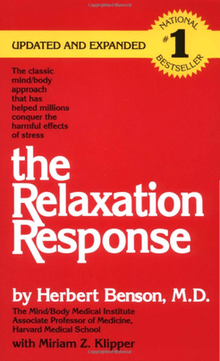The Relaxation Response
The Relaxation Response is a book written in 1975 by Herbert Benson, a Harvard physician, and Miriam Z. Klipper.[1] The response is a simple, secular version of Transcendental Meditation ("TM"), presented for people in the Western world.[2]
 A reissue from 2001 | |
| Author | Herbert Benson and Miriam Z. Klipper |
|---|---|
| Country | USA |
| Language | English |
| Publisher | HarperCollins |
Publication date | 2000 (Updated and expanded) |
| Pages | 240 |
| ISBN | 978-0-380-81595-1 |
Origin
Benson writes in his book, "We claim no innovation but simply a scientific validation of age-old wisdom".[3] People from the Transcendental Meditation movement, who felt they could reduce blood pressure using TM, visited Harvard Medical School in 1968, asking to be studied. The school, which at the time was studying the relationship of monkeys' behavior and blood pressure, told them "No, thank you." But when they persisted, Benson told them he would study them. He met with Maharishi Mahesh Yogi first to find out if he could agree in advance to any outcome, which Mahesh did. Benson mentions in his book that independent studies were already underway by then-PhD candidate R. Keith Wallace working with Archie Wilson at the University of California, Los Angeles, but that no published studies of TM existed.[4]
Eliciting the response
The Benson-Henry Institute at Massachusetts General Hospital teaches how to elicit the response in nine steps. Benson's website and his book describe four steps.[5] Two of those steps are essential: a mental device (a simple word, phrase or activity to repeat to keep the mind from wandering) and a passive attitude.[5][6] The goal is to activate the parasympathetic nervous system, which causes humans to relax.
Fight-or-flight
Benson developed the idea of the response, which counters the fight-or-flight response described during the 1920s by Walter Bradford Cannon at the Harvard Medical School.[7] According to Benson more than 60 percent of all visits to healthcare providers are related to stress. It causes the “fight or flight” hormones, epinephrine and norepinephrine, to secrete into the bloodstream. This incites or exacerbates a number of conditions. They include hypertension, headaches, insomnia, irritable bowel syndrome and chronic low back pain, as well as heart disease, stroke and cancer.[8]
A physician with ABC News adds that the immune system works best when relaxed. He said about twenty deep breaths per day, done "with intention", can accomplish this.[9]
Reception
In a 1986 US national survey, reported in The New York Times, this best-seller was the number one self-help book that clinical psychologists recommended to their patients.[10]
Notes
- Benson, copyright page
- Benson, p. 129
- Benson, pp. xxxii, 129.
- Benson, pp. 61–63.
- "How to Bring Forth the Relaxation Response". Herbert Benson. Retrieved December 11, 2011.
- "Eliciting the Relaxation Response". Benson Henry Institute for Mind Body Medicine, Massachusetts General Hospital. Archived from the original on November 30, 2011. Retrieved December 11, 2011.
- MacDonald, Ann (November 10, 2010). "Using the relaxation response to reduce stress". Harvard University. Retrieved December 11, 2011.
- Taking Charge, Massachusetts General Hospital Magazine, 2012
- Dr. David Rakel (December 17, 2009). What Is The Relaxation Response?. ABC News. Retrieved December 15, 2011.
- Goleman, Daniel (July 6, 1989). "Health: Feeling Gloomy? A Good Self-Help Book May Actually Help". The New York Times. Retrieved December 15, 2011.
References
- Benson, Herbert, 1975 (2001). The Relaxation Response. HarperCollins. ISBN 0-380-81595-8.
External links
- Benson's website – for the Relaxation Response (RelaxationResponse.org)